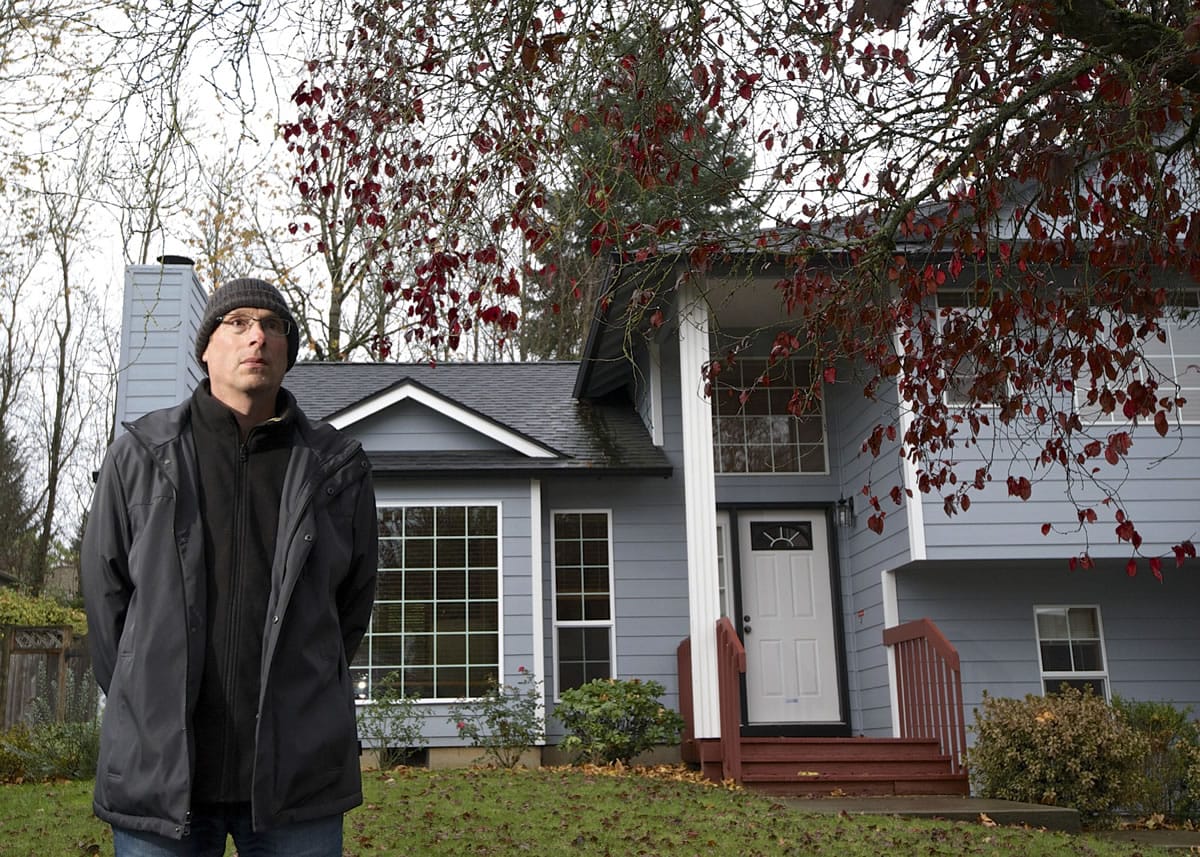Click to use an interactive map of home prices in Clark County.
David Capolarello bought his home in a quiet Hazel Dell neighborhood in 2008. At the time, housing prices were near their peak following a stratospheric climb that was fueled by easy money and low or no-down payment deals. Homeownership was on the rise, and some thought the good days would keep on rolling.
We know the rest of the story. The housing bubble collapsed everywhere with frightening speed, contributing to an economic collapse that we now call the Great Recession. And Capolarello’s investment in his home has yet to yield a return in equity.
He purchased the house in 2008 for $290,000. Since then, the assessed value has plummeted tens of thousands of dollars, and despite some recent gains, today it’s still about $50,000 short of what Capolarello paid.
“I would’ve liked the choice of the opportunity to sell,” he said. “The main impact for me is it’s solidified the fact that I’m not going to sell. If it had risen quite steeply after I bought it, I might have been tempted to sell it, because I could make a profit.”
Capolarello’s story is the story of Clark County’s housing market over the past decade. Housing prices peaked between April 2006 in Orchards and April 2008 in a portion of Hazel Dell. More than a half-decade later, median home sales prices have not rebounded to pre-recession levels in any part of the county, The Columbian found in its analysis of home sales data compiled by the RMLS real estate listing service. Broken down by ZIP code, the analysis shows median sales prices are still 10 percent to 43 percent lower than pre-recession levels.
In east Vancouver’s 98684 ZIP code, the median sales price of $247,500 in September remained just 10 percent below the $275,000 peak in August 2007. Farther east, Washougal’s 98671 ZIP code has seen one of the largest price drops. There, the September median sales price of $254,940 was a dismal 43 percent below the December 2006 peak of $450,000. (The Columbian’s analysis generally excluded rural areas because of their small number of home sales).
Those numbers are considered by many to be imperfect indicators of real estate values. They are influenced by seasonal variations, new housing construction that can elevate or lower prices of surrounding homes, and the number of home sales, among other factors. They are not adjusted for inflation. Nevertheless, the overall picture of housing prices tracking well below the peak of the last decade’s housing bubble resonates with many in the housing industry.
“I don’t find it surprising at all,” said Mike Lamb, a veteran real estate broker at Windermere Stellar Vancouver who regularly tracks local housing trends. With such a huge drop in sales prices, Lamb said, full recovery is a long-term endeavor.
“We’re continuing to see (housing price) appreciation,” he said. “I don’t see anything to suggest that it isn’t going to continue.”
The price gyrations of the past decade seem less dramatic when viewed on a longer timeline. An analysis of housing price changes from the mid-1990s to today shows moderate growth over time, with the huge ups-and-downs of pre-recession bubble and the subsequent crash leveled out, said Scott Bailey, regional economist with the Employment Security Department.
But that market turmoil, which pushed countless homeowners “underwater” with loans worth more than the value of their homes, triggered a long-term change in the housing market. Quick-cash home flippers who helped build the bubble have all but disappeared. Legitimate investors are less willing to take risks in a market with slowly rising prices. Tightened lending rules and stagnant wages have reduced the numbers of first-time homebuyers. Buyers of all income ranges have become more cautious.
Not surprisingly, apartment construction has exploded to about 40 percent of new housing permits, Bailey said.
“Are we back to normal? Probably not,” he said.
But many brokers, such as Patrick Ginn with Vancouver’s Ginn Realty Group, take the delayed recovery in home prices as a sign of a more stable, realistic market.
“The decline was so dramatic and significant, I don’t think it would be healthy to see it go back up as quick as it went down,” Ginn said. “So, what we’re seeing is a much more cautious buyer, much more cautious lenders, much more cautious appraisers.”
Property values drop
While the real estate market measures only a slice of property values, Clark County’s tax appraisals take in all properties. Numbers from the county assessor’s office show that the taxable assessed value of all property in the county dropped by more than 26 percent in the five years from the 2007-08 fiscal year to 2002-13, the lowest point of the past decade. They started to climb in that year but are still 19 percent below their peak.
Clark County Assessor Peter Van Nortwick said the real estate investment frenzy of the past decade was a factor in the devastating housing price run-up.
“There were a lot of investors that were driving prices up, and they kept going until it crashed,” he said. “I don’t think that exists any more.”
Real estate brokers are encouraged that many buyers have returned to the market. Homes sold last month had been on the market on average for on 75 days, down from 85 days October 2013. Median sales prices in Clark County for the year through October increased by 7.8 percent from the same 10-month period of 2013, RMLS reported. Indeed, real estate brokers regularly raise concerns that the county could soon face a shortage of buildable lots for new homes, at least in the middle and upper price ranges.
“I’ve seen in some desirable neighborhoods where you can make the argument that prices have bounced back entirely,” said Becky DeHaan, broker at Keller Williams Realty in Vancouver. While not disputing the overall numbers, DeHaan said the only fair comparison of then-and-now prices would be an examination of price changes for individual homes.
Terry Wollam, managing broker at ReMax Equity Group-Wollam & Associates, agrees that desirable, well-established neighborhoods fared best through the downturn.
“We saw people revert to the core areas and most desirable areas, and still saw activity within those markets,” Wollam said.
The outlying areas as far as Kalama, Woodland, and Washougal, where new construction was taking place at a frenzied pace, suffered the biggest crash as hard-to-sell new homes dragged down prices in a shrinking market.
In the case of Washougal, Wollam said prices for view lots began to rival those of Camas, which the market generally perceives as a more desirable community for high-end homebuyers. The downturn brought prices closer to historical patterns, he said.
But if lenders were too lax in the past, many in the industry say the tightened down payment requirements and loan approval strandards have become too stringent in response to the housing meltdown. Wollam estimated that he could win loan approval for nine out of 10 prospective buyers in the housing boom days, and that perhaps five of those 10 would qualify under today’s standards.
He said he isn’t looking for a return to the too-easy financing practices of the past, when loan lenders approved what became known as “liar loans” because they required no documentation of income. But he’d like lending practices that could perhaps notch approval up to seven out of 10 prospective buyers.
With the huge secondary lenders Fannie Mae and Freddie Mac looking at an easing of lending rules, he sees hope for a stronger real estate market. Fannie Mae and Freddie Mac “are the ringbearers for where the market is headed,” Wollam said. “We’re going to start seeing some positive effects and get more to where we need to be.”
Ginn, the Realtor, suspects it could be three to five more years before prices in the local housing market return to their peak value from several years ago. But he’s encouraged that the slower recovery may prevent another housing bubble.
“I think the process that is happening in a way that’s sustainable, (and) not something that’s going to crash again, is the key part of that,” he said.





